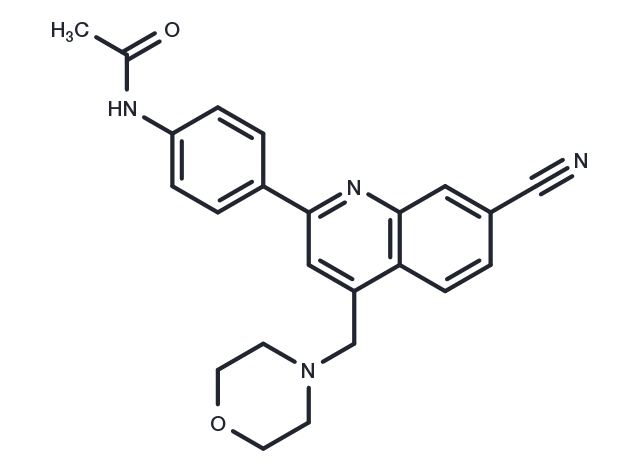Powder: -20°C for 3 years | In solvent: -80°C for 1 year


RAGE 229, N-(4-(7-cyano-4-(morpholin-4ylmethyl) quinolin-2-yl)phenyl)acetamide, is an orally active ctRAGE-DIAPH1 inhibitor. RAGE 229 can inhibit the intracellular RAGE signaling by inhibiting the interaction between the cytoplasmic tail of RAGE(ctRAGE) and Diaphanous-1(DIAPH1) [1].

| Pack Size | Availability | Price/USD | Quantity |
|---|---|---|---|
| 2 mg | 5 days | $ 595.00 | |
| 5 mg | 5 days | $ 970.00 | |
| 25 mg | 6-8 weeks | $ 1,170.00 | |
| 50 mg | 6-8 weeks | $ 1,530.00 | |
| 100 mg | 6-8 weeks | $ 2,500.00 |
| Description | RAGE 229, N-(4-(7-cyano-4-(morpholin-4ylmethyl) quinolin-2-yl)phenyl)acetamide, is an orally active ctRAGE-DIAPH1 inhibitor. RAGE 229 can inhibit the intracellular RAGE signaling by inhibiting the interaction between the cytoplasmic tail of RAGE(ctRAGE) and Diaphanous-1(DIAPH1) [1]. |
| In vitro | RAGE229 demonstrates high affinity for ctRAGE, exhibiting a dissociation constant (K D) of 2 nM, and effectively inhibits smooth muscle cell (SMC) migration, as indicated by an inhibitory concentration 50 (IC 50) value of 26 nM [1]. In a Cell Migration Assay [1], employing SMCs at concentrations ranging from 0.00006 to 10 μM and an incubation time of 1.5 hours, RAGE229 consistently inhibited SMC migration, reaffirming its IC 50 value at 26 nM. |
| In vivo | RAGE229, administered via oral gavage at a dosage of 5 mg/kg twice daily for four days, effectively mitigates both short- and long-term diabetic complications in mice. Additionally, RAGE229, given either orally or intravenously (150, 50, and 15 ppm chow; 30, 10, and 3 mg/kg per day per mouse) and through intraperitoneal injections (5 mg/kg, every 12 hours for four total doses), significantly reduces plasma levels of pro-inflammatory markers TNF-α, IL-6, and CCL2/JE-MCP1 in diabetic mice. This results in decreased pathological and functional signs of diabetes-like kidney disease. In female CF-1 and male diabetic mice, a dosage of 5 mg/kg administered orally twice daily for four days lowered inflammation scores and the area of infarcts. Similarly, in C57BL/6J and BTBR ob/ob mice models, varying dosages (30, 10, and 3 mg/kg; 5 mg/kg) delivered orally or intravenously, including specific chow concentrations (150, 50, and 15 ppm) and intraperitoneal injections (5 mg/kg, every 12 hours for four doses), effectively reduced the concentrations of inflammatory markers CCL2, TNF-α, and IL-6. |
| Molecular Weight | 386.45 |
| Formula | C23H22N4O2 |
| CAS No. | 2143072-85-7 |
Powder: -20°C for 3 years | In solvent: -80°C for 1 year
You can also refer to dose conversion for different animals. More
bottom
Please see Inhibitor Handling Instructions for more frequently ask questions. Topics include: how to prepare stock solutions, how to store products, and cautions on cell-based assays & animal experiments, etc.
RAGE 229 2143072-85-7 inhibitor inhibit
